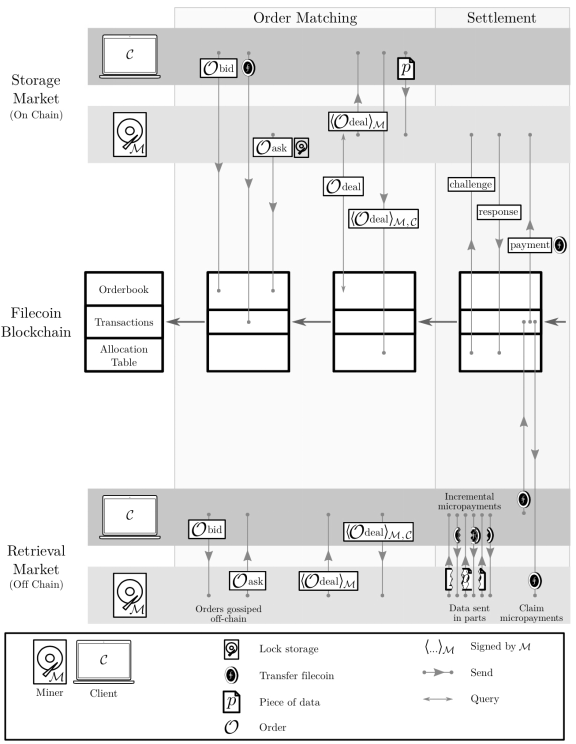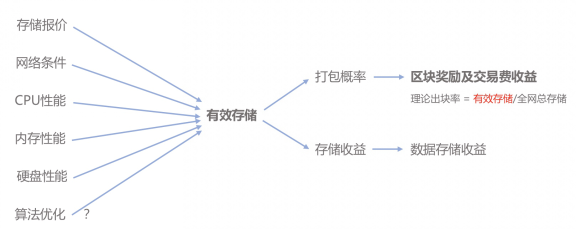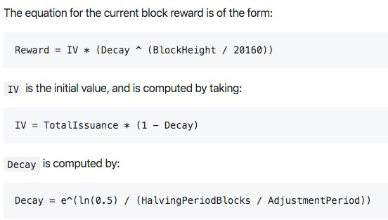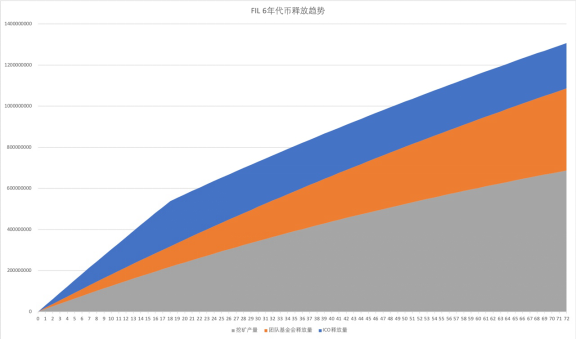Read the relationship between Filecoin and IPFS in one article: Is Filecoin really the next gold mine?

What is Filecoin? What is the relationship with IPFS?
IPFS is a network protocol with a series of excellent features such as content addressing and version control. It ensures that files are stored and transmitted securely in a P2P network. IPFS is considered to be the next generation network transport protocol and will have the opportunity to replace HTTP. protocol. Filecoin is a decentralized storage system based on the IPFS network protocol. Both IPFS and Filecoin are developed by Protocol Labs. Filecoin adds a market mechanism to adjust the storage table based on the IPFS protocol, and increases the incentive mechanism to ensure stable operation of the system. In the Filecoin system, users can select the service at the corresponding price based on their own conditions such as speed, number of copies, and budget.
- Viewpoint | Reward points are meaningless compared to blockchain rewards
- The financial structure of the Ethereum Ecology: How does it work?
- Popular Science | Long-distance attack problem of PoS protocol
Filecoin uses the EC (Expected Consensus) consensus, which is similar to the PoS consensus, but the difference is that Filecoin determines the probability of packing rights to be valid storage, not the amount of tokens collateralized. Effective storage is one of the main features that Filecoin distinguishes from other similar projects. To determine efficient storage, Filecoin introduced PoRep (Proof of Replication) and PoSt (Proof of Spacetime) proofs, in which PoRep is used to prove that a node stores a copy of the corresponding file on physical storage, and PoSt is used to prove that it is at a certain time. During the cycle, a node stores the corresponding file.

What is the outlook for Filecoin?
To talk about the prospect of a new product, it is nothing more than a cost and experience perspective, compared to its competing products, whether there is a lower cost, or a better user experience. There is no doubt that IPFS is currently the best decentralized storage protocol. Compared with the existing centralized file system, it has a series of advantages such as content addressing, version control, and non-tampering. This article focuses on Filecoin mining. Relevant content, specific advantages are not discussed in detail, if you are interested, you can learn more through the participation data at the end of the article). The IPFS protocol can ensure the safe and efficient storage and transmission of files in a P2P network. However, in large-scale applications in a P2P network, the system needs to be self-motivated and operated. In this case, a corresponding mechanism needs to be introduced to implement the Filecoin. It came into being.
In the traditional blockchain field, the cost of information storage is extremely high. For example, storing 1MB of data on Ethereum can reach tens of thousands of dollars at the highest cost, which greatly hinders the development and application of DApp. In the 19-year project presented by the Web3 conference in Berlin, storage projects accounted for more than 10%, which is enough to illustrate the urgency of solving storage problems in the blockchain field. Among all the decentralized storage projects, Filecoin is undoubtedly the most concerned, and IPFS has been running stably for two years, which fully proves the robustness of its underlying protocol, but the actual effect of Filecoin needs to be tested by practice. Of course, there are also some blockchain storage projects that are improvements for centralized cloud storage services. For example, Siacoin has a storage cost of only 1/10 of the centralized storage, but so far, the data stored on the Sia platform is only 2PB. The reason is mainly because the user has a high threshold and the experience is not good.
Whether Filecoin can capture the market share of traditional centralized storage depends on its ultimate user experience and its storage price. For the time being, most of the Filecoin nodes are deployed in the IDC room. The actual deployment and operating costs are not reduced compared to the traditional centralized cloud storage, and the storage process is more complicated (requires running PoRep and PoSt, which has a large number of zero-knowledge proof operations, causes its actual storage cost to be higher. Therefore, in the early days of Filecoin's launch, the actual storage cost of data may be higher than that of centralized cloud storage, but the initial storage node may reduce the storage price in order to obtain block rewards, which may result in the actual storage price being lower than the traditional centralized cloud storage.
In the long run, Filecoin still needs to take full advantage of its P2P storage, transform storage devices from specialization to civilian use, and optimize its algorithms to reduce storage costs without affecting the user experience. The storage problem is an important issue to be solved in the blockchain field, so a large number of storage projects were presented at the 19th Web3 Summit. IPFS is an important part of the Web3 vision. Its development will affect the development of Web3 to a certain extent. Similarly, the development of Web3 determines the future of IPFS to a certain extent. Filecoin is an IPFS-based storage class project initiated by IPFS. There is no doubt that it is highly anticipated.


Different from the above picture, in the initial version of Filecoin, the order matching mechanism was not implemented in the storage market and the retrieval market, but the grabbing mechanism was adopted. The three major parts of Filecoin correspond to three processes, namely the stored procedure, the retrieval process, and the block packaging and reward process. The simplified process and miners' income are shown in the following figure:

As can be seen from the above, unlike the traditional PoW mining, Filecoin's mining process is much more complicated, and an important factor in determining the profit of the previous mining is effective storage. Effective storage is a core feature that distinguishes Filecoin from other decentralized storage projects. In Filecoin's EC Consensus, effective storage is similar to the interest in PoS, which determines the probability that a miner will acquire the right to pack, that is, the proportion of miners effectively stored in the entire network is proportional to its final mining revenue. The factors that determine effective storage are shown in the figure below, including hardware performance such as storage quotation, network conditions, CPU performance, etc. Of course, it is also possible to obtain higher effective storage under the same hardware conditions by optimizing the mining algorithm. However, the current increase in the number of benefits that algorithm optimization can bring is still an unknown.

In the EC consensus, the effective storage is similar to the interest in the PoS consensus, and the decision of the packing probability in Filecoin is not the effective storage of the node's single block period, but all the effective storage after the main online line, Filecoin will have a certain horse. Too much effect, the sooner people participate, the more advantage they have. However, unlike the PoS consensus, storage on Filecoin is a non-reusable resource. Therefore, when the storage space of a node is occupied, the effective storage will not grow any more. To obtain more revenue, you need to Further increase the corresponding hardware, and at this time it becomes a "latecomer."

Filecoin token release
Unlike most projects, the Filecoin token release strategy is linear release, and the team and foundation and ICO tokens are linearly released, that is, each part of the token is gradually released with mining in each block. The Filecoin mining release is also different from other projects. The Filecoin mining award is halved every 6 years. The halving amount is derived from the following formula:

After calculation, Filecoin's initial one-day block reward was 440,000, and the one-day reward decreased to 395,000 after one year, and decreased to 220,000 at the end of the sixth year. The linear halving was completed. This way of halving is undoubted to the miners. It is very beneficial. Based on the above information, Filecoin's full-network tokens for the past 6 years are shown in the following figure (since the private placement and ICO partial linear release unlocking periods range from 6 months to 3 years respectively, the average value is released in 1 and a half years):

As can be seen from the above figure, due to the linear release strategy, Filecoin tokens were very scarce in the early days, and further scarcity was caused by the need to mortgage a certain number of Fil tokens in participating in Filecoin. Therefore, it is foreseeable that the early price of the Fil token will be relatively high, but as the token is released, the price will continue to fall. The actual token price trend may not be exactly the same as the above forecast, because the price influence factor, in addition to the token amount, the market heat and the supply and demand relationship will also have an impact on the price, but it should be emphasized that in the long run, the generation The amount of coins is one of the most important price factors.

Filecoin return cycle and revenue measurement
First of all, it should be emphasized that Filecoin is not online yet. It is difficult to measure the return cycle, and the accuracy cannot be guaranteed. However, it is still possible to make a rough estimate of the benefits. As shown in the table below, the table below shows the approximate release of the first-day currency in the main line. (Because the initial mining release amount is 440,000 in the first year, the mining release amount is 395,000 at the end of the first year, so the average is taken. Value 420,000).

It can be seen that in the first year of the main online line, the number of Fil tokens released per day is about 1 million, and 30 million each month. Assuming that the number of tokens produced by the single-network computing power of the whole network is the same, the current cycle can be calculated by the following formula.

Among them, the calculation price is the quotation of the mining machine manufacturer, and the daily total mining output quantity is determined to be about 420,000 pieces. The expected return price can be estimated by simply substituting the expected currency price and the expected full network computing power into the formula. Regarding the price of the currency, this article does not make too much analysis. The official estimate of the whole network computing Protocol Labs is 100EB, but it can still be observed if it can be achieved. As for the income, the same idea can be used to make a rough estimate.

What issues should I pay attention to when participating in Filecoin?
1. The transparency of mining machines or computing power
At present, there are two main ways to sell Filecoin mining machines, namely direct sales of mining machines and sales by calculation. The transparency of mining machines is relatively high, and the same kind of hardware can find the corresponding price on the e-commerce platform.
The calculation of sales refers to the way of quoting and selling at a single T price. This is to some extent borrowed from the pricing method of PoW mining, but they are very different. Taking Bitcoin as an example, the bitcoin computing power is calculated by T, and its unit is H, that is, the number of times the Hash algorithm is executed every second. The unit is directly related to the mining component chip of the core of the mining machine, and the bitcoin main network It has been on the line for many years and the transparency of the mining machine has been very high.
Filecoin is denominated in T, and its unit is B, which is commonly referred to as the byte. The unit directly related to the unit is the hard disk space of the mining machine. As mentioned above, the key parameters for determining Filecoin mining are valid. Storage, this is not much related to the storage space of the mining machine itself. Factors that determine whether storage space can be effectively stored include a range of hardware and software conditions such as CPU performance and network conditions. It is still unknown how many outputs can be produced by each vendor's single-T computing power.
Of course, it is not that the method of pricing by T is completely incorrect. Under the premise that the transparency is high enough (can know the exact hardware behind each T calculation power), the method of pricing by T is also reasonable. However, before the Filecoin main online line, because the information is opaque, according to the T price, there are many ways for the manufacturer to move hands and feet. Therefore, it is necessary to be very cautious when purchasing the power according to T, and to participate as much as possible while ensuring information transparency. After the Filecoin main online line, no matter how much hardware behind the single T, the price can be evaluated directly by calculating the single T output. At this time, the T price will be very intuitive.
2. Test network mining problem
After Filecoin tests the online line, whether there are rewards or rewards for participating in mining, the specific plan has not been announced. At present, Protocol Labs officially announced the main online line plan, launched the test network on December 11, and launched the main network in March 2020. However, empirically, it is unlikely that the test network will mine directly in the normal proportion. For example, Polkadot's test network Kusama, mining on Kusama is not directly related to the Polkadot main network. For example, Nervos' test network mining, only a certain amount of the main net currency as a mining reward. Therefore, after Filecoin tests the online line, it is not recommended to be eager to participate in mining.
3. The effect of algorithm optimization on mining efficiency
Frankly speaking, this issue is currently very uncertain. Because Filecoin differs from PoW in mining, the algorithm accounts for a relatively high degree. Therefore, algorithm optimization will have a certain impact on mining efficiency, but the specific impact can be large, whether it is consistent with the claims of various manufacturers. It will always be a line before the main online line. Unknown, this will also be the biggest uncertainty factor for the previous investment. It can be confirmed that due to the survival of the fittest in the market, the computing output level of the whole network will eventually become basically the same. Therefore, the advantages of algorithm optimization are mainly concentrated in the early stage, and as the market matures, its advantages will be gradually weakened.

"to sum up"
The storage problem of blockchain needs to be solved urgently, and Filecoin is the most anticipated project to solve this problem, and the IPFS protocol has been running stably for more than two years, so Filecoin itself is very worth looking forward to. However, before the main online line, the opacity of information is very high, and there are also many traps. Therefore, if you want to participate in early mining, please make full investigation and research.
Although Filecoin mining has a certain Matthew effect, digging the "head mine" has certain advantages. Before the main online line, the risk of participating in mining is very high, because the information uncertainty and opacity are very high at this time. Therefore, whether Filecoin is the next gold mine still needs time to test, but it can be determined that the risk is far greater than the income when the information is not fully grasped.
– END –
Author: Fan Xu new
Source: Fundamental Labs
We will continue to update Blocking; if you have any questions or suggestions, please contact us!
Was this article helpful?
93 out of 132 found this helpful
Related articles
- Former Federal Reserve official 怼 Bank of England Governor: The idea of cryptocurrency replacing the US dollar is unreasonable
- Analysis: What opportunities, challenges and risks will be brought by blockchain technology for digitalization of securities?
- Stable currency analysis: Most stable coins will not be used for large transactions except USDT
- Exchange Real Volume Report (on) | TokenInsight
- Gartner reports: Blockchain business is facing a test, the industry is still dark
- Bakkt also can't impact traditional cryptocurrency futures trading? – Coin, OKex, Matcha, and the same station
- Market Analysis: Bitcoin rebounds infinitely, still a short world






